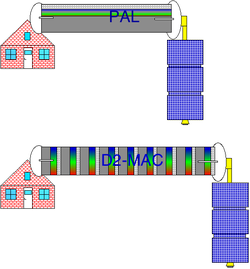
A-MAC
Encyclopedia


MAC FAQ
MAC transmits luminance and chrominance data separately in time rather than separately in frequency (as other analog television formats do, such as composite video).Audio and Scrambling (selective access)
- Audio, in a format similar to NICAMNICAMNear Instantaneous Companded Audio Multiplex is an early form of lossy compression for digital audio. It was originally developed in the early 1970s for point-to-point links within broadcasting networks...
was transmitted digitally rather than as an FM subcarrier. - The MAC standard included a standard scrambling system, EuroCrypt, a precursor to the standard DVB-CSA encryption system.
External links
- Multiplexed Analogue Components in "Analog TV Broadcast Systems" by Paul Schlyter
TV transmission systems
- Analog high-definition television systemsAnalog high-definition television systemsHistorically, the term high-definition television was first used to refer to a analog video broadcast television system developed in the 1930s to replace early experimental systems with as few as 12-lines. On 2 November 1936 the BBC began transmitting the world's first public regular...
- PALPALPAL, short for Phase Alternating Line, is an analogue television colour encoding system used in broadcast television systems in many countries. Other common analogue television systems are NTSC and SECAM. This page primarily discusses the PAL colour encoding system...
, what MAC technology tried to replace - SECAMSECAMSECAM, also written SÉCAM , is an analog color television system first used in France....
, what MAC technology tried to replace - A-MAC
- B-MACB-MACB-MAC is a form of analog video encoding, specifically a type of B-MAC is a form of analog video encoding, specifically a type of B-MAC is a form of analog video encoding, specifically a type of (Multiplexed Analogue Components (MAC) encoding. MAC encoding was designed in the mid 80s for use with...
- C-MACC-MACC-MAC is the variant approved by the European Broadcasting Union for satellite transmissions. The digital information is modulated using 2-4PSK , a variation of quadrature PSK where only two of the phaser angles are used....
- D-MACD-MACAmong the family of MAC or Multiplexed Analog Components systems for television broadcasting, D-MAC is a reduced bandwidth variant designed for transmission down cable....
- E-MACE-MACE-MAC is 16:9 version of C-MAC. Originally E-MAC was designed for 15:9 pictures, it later adopted the 16:9 aspect ratio. The format is backwards compatible with C-MAC. It embeds additional information in field blanking and line blanking signals. E-MAC has a lower data capacity because of this...
- S-MAC
- D2-MAC
- HD-MACHD-MACHD-MAC was a proposed broadcast television systems standard by the European Commission in 1986 . It was an early attempt by the EEC to provide High-definition television in Europe. It was a complex mix of analogue signal , multiplexed with digital sound...
, an early high-definition television standard allowing for 2048x1152 resolution. - DVB-SDVB-SDVB-S is an abbreviation for Digital Video Broadcasting — Satellite; it is the original Digital Video Broadcasting forward error coding and demodulation standard for satellite television and dates from 1994, in its first release, while development lasted from 1993 to 1997...
, MAC technology was replaced by this standard - DVB-TDVB-TDVB-T is an abbreviation for Digital Video Broadcasting — Terrestrial; it is the DVB European-based consortium standard for the broadcast transmission of digital terrestrial television that was first published in 1997 and first broadcast in the UK in 1998...
, MAC technology was replaced by this standard

